#jomon culture
Photo

Jar
“When rice cultivation and bronze and iron metallurgy were introduced, probably through Korea, the isolated and self-sufficient life of the Jomon gave way to a communal society organized to carry out the demanding agricultural cycle...
The social and aesthetic character of the transformed culture of Yayoi is vividly reflected in its ceramic vessels.” - MET
#pottery#japanese art#jomon culture#yayoi culture#neolithic#bronze age#iron age#japanese art history
13 notes
·
View notes
Text




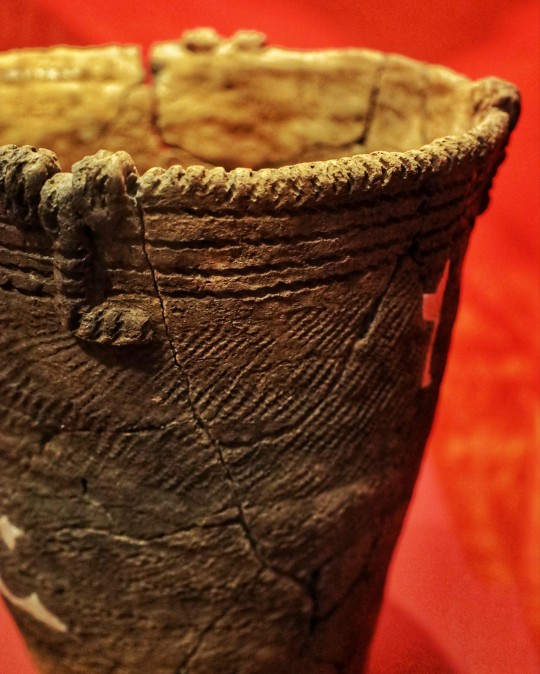


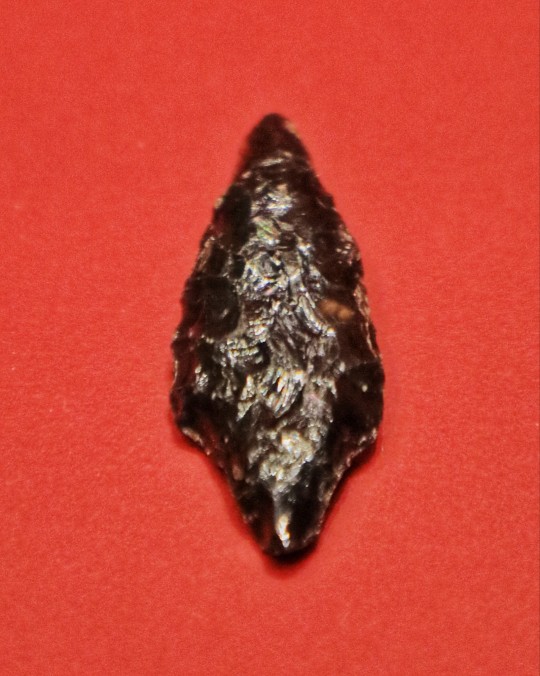
Middle Jomon Pottery and Worked Tools, Japan, 5000 years old, 'Circles of Stone: Stonehenge and Prehistoric Japan' Exhibition, Stonehenge Visitor Centre, Wiltshire
#Japan#japanese art#pottery#pottery design#prehistoric tools#arrowheads#stonework#blades#archaeology#Stonehenge#prehistory#ancient craft#ancient living#ancient cultures#jomon
40 notes
·
View notes
Text
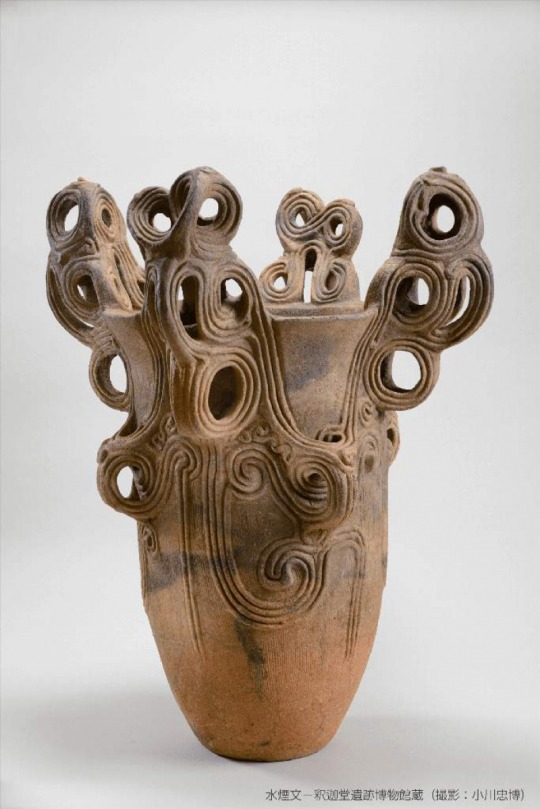
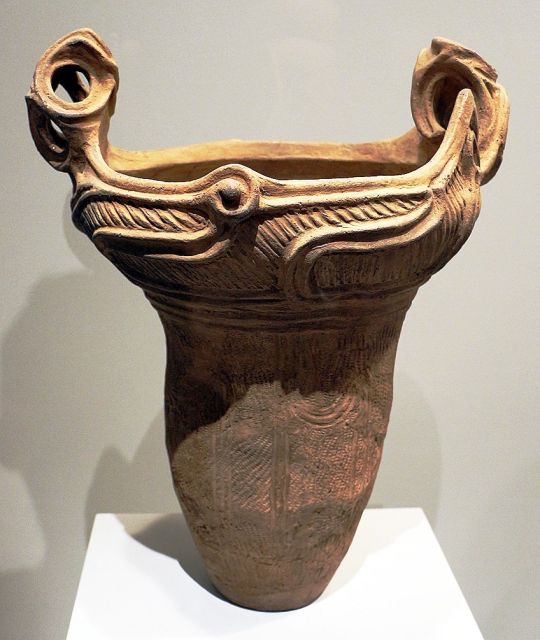
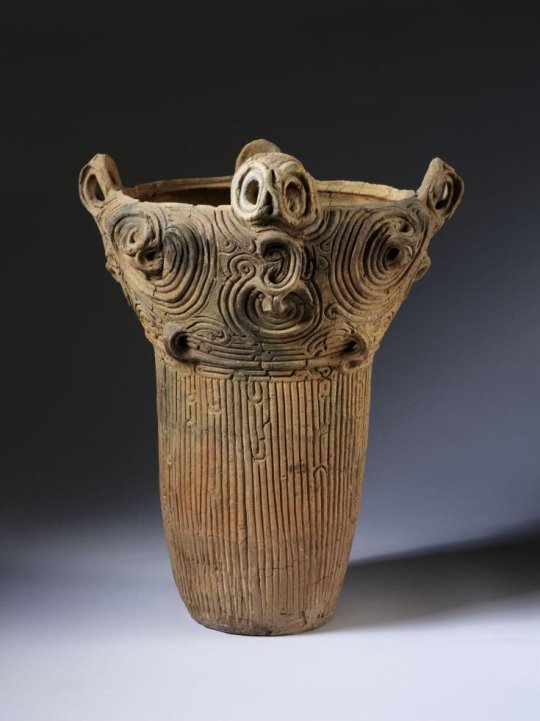

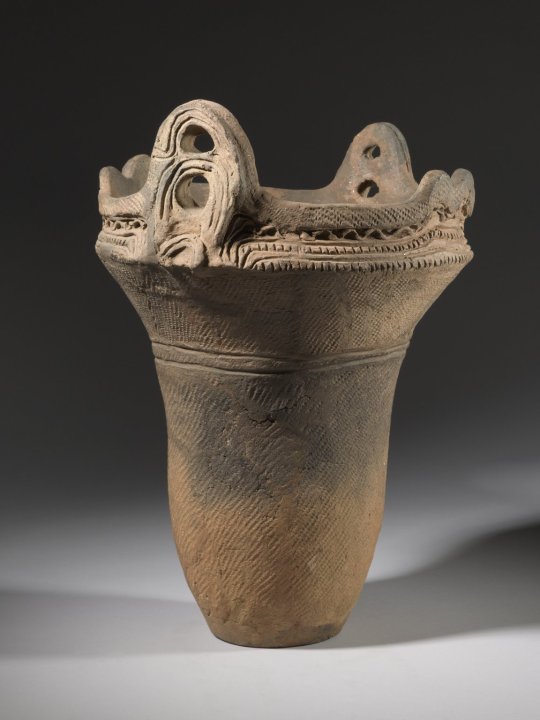
JŌMON POTTERY VESSELS ARE THE OLDEST IN THE WORLD..."
PIC INFO: Spotlight on a Neolithic Jomon vessel from Japan, c. Middle Jōmon Period (c. 3,500? - 2,500 BCE), designated National Important Cultural Properties in 1988.
MINI-OVERVIEW: "Jōmon pottery vessels are the oldest in the world. They are characterized by their decoration from impressions, which resemble rope. The word Jōmon means "cord markings" or "patterns."
Because the Jōmon period covered a great deal of time, the vessels themselves changed throughout the period.
THE ART OF EDUCATION (University)
Address: Fuefuki City Yamanashi
Category: Cultural Heritage/Japan Heritage
Source: https://jomon.co/en/point/detail/14, The Art of Education, Met Museum, Explore the Collections, Brooklyn Museum, various, etc...
#Japanese Pottery#Japanese#Pottery#Jakado Site#Japan#Ancient Japan#Ancient Japanese#Ancient Pottery#Ancient Cultures#Ancient Civilizations#Middle Jomon Period#Jōmon Culture#Middle Jōmon Period#Jōmon Vessel#Vessel#Jōmon Vessels#Jomon Pottery#Pottery Vessels#Jōmon Pottery#Jōmon#Jōmon Period#Vessels#Archeology#Japanese Neolithic Pottery#Jōmon Ware
5 notes
·
View notes
Photo

If the Ainu people are indigenous to Japan, then where did the Japanese come from?
Japan is a country steeped in rich history and culture, but have you ever wondered about the origins of its people? The Japanese people are believed to have descended from a mixture of different ethnic groups that migrated to the Japanese archipelago over thousands of years.

The earliest known inhabitants of Japan were the Jomon people, who lived in Japan from around 14,000 BC to 300 BC. They were a fascinating group of hunter-gatherers who created some of the earliest pottery in the world, leaving a unique mark on Japan's ancient history.
Around 300 BC, a new group of people, known as the Yayoi, migrated to Japan from the Korean peninsula. These people brought with them new technologies such as rice farming, iron tools, and bronze and iron weapons. The Yayoi people intermixed with the Jomon people, and their culture gradually spread across Japan, shaping the country's culture and traditions.
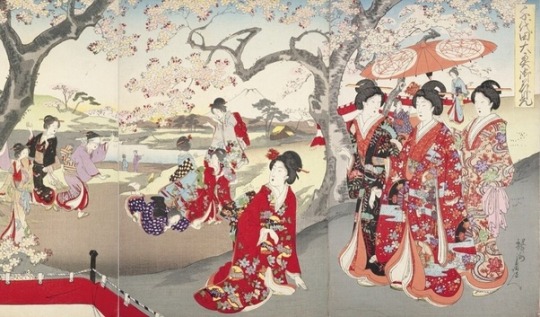
The Kofun period, which lasted from the 4th to the 7th century AD, saw the emergence of a new group of people known as the Kofun. They were characterized by their large burial mounds and were believed to be ancestors of the modern-day Japanese people. During this time, Japanese society became more centralized and complex, setting the stage for Japan's future as a major world power.
Over the centuries, Japan was influenced by various cultures, including Chinese, Korean, and Southeast Asian cultures. These influences helped shape the unique traditions and customs that make Japan the vibrant and fascinating country it is today.

While the Ainu people are considered indigenous to Japan, they have historically faced discrimination and forced assimilation by the Japanese government. Today, efforts are being made to preserve and promote Ainu culture and traditions, giving a voice to an important part of Japan's history that was once silenced.
#ainu#nippon#japan#east asian#kemetic dreams#kotun#southeast asian cultures#chinese#kkorean#komon#jomon#yayoi
47 notes
·
View notes
Photo

Unknown
_
Female dogū figurine, Japanese Jomon Period 12,000 B.C. to 300 B.C. Photo courtesy Tadahiro Ogawa.
For 30 years Ogawa-san has being photographing Jomon Period artifacts, developed a special technique and has around 30,000 of them in his archive.
Tadahiro Ogawa’s book, “Jomon Bijutsukan (Jomon Art Museum),” published in 2013, features more than 500 photographs of Jomon Period artifacts. An online translation of the book is also being produced at jomonarts.com.
https://www.greenshinto.com/2013/09/29/jomon-artifacts/
#Jomon#Japan#culture#history#prehistoric#ceramic#female#figure#Tadahiro Ogawa#photography#technique#hi resolution
43 notes
·
View notes
Text
Gathered in an exhibition room at Stonehenge, around 80 objects made in Japan during the Jōmon period, roughly the same time the great stone circle on Salisbury Plain was built, highlight some beguiling parallels between two cultures separated by thousands of miles.
The exhibition, Circles of Stone: Stonehenge and Prehistoric Japan, reveals that prehistoric people in southern Britain and in Japan took great trouble to build stone circles, appear to have marked and celebrated the passage of the sun and felt moved to come together for festivals or rituals.
“Of course they couldn’t possibly have any idea what each other was doing,” said Martin Allfrey, senior curator for English Heritage. “But it is tantalising to look at what these extraordinary objects from Japan tell us about the similarities between these communities who were perhaps ideologically closer than one might imagine. Exploring what is happening elsewhere in the prehistoric world is key to understanding the significance of Stonehenge.”
At about the time Stonehenge’s builders were creating the monument, their Japanese counterparts were coming together to make sites such as the Ōyu stone circles in northern Japan. These do not feature the sort of hulking standing stones that Stonehenge is famous for but rather large circles made of thousands of river pebbles. Like Stonehenge, they appear to be aligned to mark solstices.
Star of the show at Stonehenge is the Jōmon cooking pot, which Simon Kaner, executive director of the Sainsbury Institute for the Study of Japanese Arts and Cultures, explained would have been placed in the fire of a Jōmon dwelling near the Shinano River. He pointed out the black marks that show it was used for making, perhaps, a fish stew. “Imagine sitting around the fireplace as a meal bubbled away in this. It must have cast the most extraordinary shadows,” he said. This is the first time the pot has gone on display outside Japan.
Finds made at the Japanese stone circles suggest people came together for feasts and venerated their ancestors, just like the people who constructed Stonehenge. The scale of their creations meant that both the ancient Britons and Japanese people must have been able to bring together large numbers of people to co-operate on ambitious, important projects.
Geography may have something to do with the parallels. The UK and Japan flank the Eurasian landmass at roughly the same latitude, meaning they have similar climates and natural resources, which both peoples exploited and adapted.
#love jomon pottery#that header image is causing me to short circuit#they took the pot on a fieldtrip to Stonehenge!!#prehistoric japan#neolithic Britain#ancient cultures#ancient history#exhibitions
13 notes
·
View notes
Text

Clay pot, Jomon culture (Japan), 3000 - 2000 BC
510 notes
·
View notes
Text



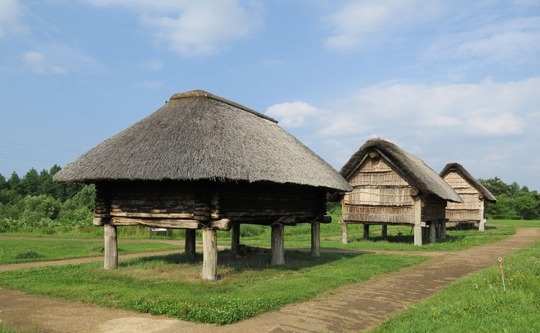
Sean bienvenidos, japonistasarqueologicos, al tercer capítulo del Japón prehistórico y seguir recorriendo sus lugares mitológicos y mágicos, una vez dicho esto póngase comandos que empezamos.
-
Para continuar nuestro viaje, más vale tarde que nunca, pero despacio y con buena letra. Nos trasladamos al yacimiento arqueológico de Sannai Maruyama en la prefectura de Aomori, localizada en la región de Tōhoku.
-
La estructura, de madera, data del periodo jomon, es una estructura que funcionó como un gran calendario, ya que algo común que tienen todas las culturas en el mundo es adorar a las estrellas en lo que respecta a la prehistoria. El yacimiento data del 3900 a.c localizado a lo largo del río Okidate en la punta de una suave colina que se extiende desde las montañas Hakkoda.
-
En la década de 1992, tuvieron lugar las excavaciones que han desenterrado los restos de viviendas en pozos, tumbas de adultos, niños y los pozos de almacenamiento, entre otros rastros de la vida cotidiana. Además de una hay una gran cantidad de herramientas de loza de piedra. Se han excavado una gran variedad de huesos de pescado y de animales que indican hábitos alimenticios de aquella gente, también fueron encontrados frutos secos: como castañas y nueces. Además, se han desenterrado muchas reliquias orgánicas, como productos de madera, herramientas de hueso, canastas tejidas, así como artículos comerciales como jade, obsidiana de áreas remotas y asfalto. Hay una teoría: en Iwate se crean estructuras similares para realizar la danza de los ciervos ¿Qué opinan al respecto?
_
Espero que os haya gustado y nos vemos en próximas publicaciones mis amantes del mundo japonés, que pasen una buena semana.
-
考古学者の日本主義者の皆さん、先史時代の日本の第 3 章へようこそ、神話と魔法の場所を旅し続けてください。 - 旅を続けるには、遅刻しないよりはマシですが、ゆっくりと上手な字で。 東北地方にある青森県の三内丸山遺跡へ移動します。 - この木造建造物は縄文時代にまで遡り、先史時代から世界のどの文化にも共通して星を崇拝しており、偉大な暦として機能していた建造物です。 この遺跡は、八甲田山系から続くなだらかな丘陵の先端、沖館川沿いに位置し、紀元前 3900 年に遡ります。 - 1992 年代に発掘調査が行われ、井戸内の住居跡、大人、子供の墓、貯蔵穴、その他の日常生活の痕跡が発掘されました。 1 つ以外にも多数の石器の道具があります。 当時の人々の食生活を示す魚や動物の骨が多数出土しており、栗やクルミなどの木の実も出土しています。 さらに、木製品、骨道具、編んだかごなどの有機遺物や、翡翠、辺境の黒曜石、アスファルトなどの交易品も発掘されています。 岩手でも鹿踊りをするために同じような建物が作られているという説がありますが、どう思いますか? _ 日本の世界を愛する皆さん、良い一週間をお過ごしください。
-
Welcome, archaeological Japanists, to the third chapter of prehistoric Japan and continue touring its mythological and magical places. Having said that, put yourself in command and let's begin.
-
To continue our journey, better late than never, but slowly and with good handwriting. We move to the Sannai Maruyama archaeological site in Aomori prefecture, located in the Tōhoku region.
-
The wooden structure dates back to the Jomon period, it is a structure that functioned as a great calendar, since something common that all cultures in the world have is worshiping the stars in regards to prehistory. The site dates back to 3900 BC located along the Okidate River at the tip of a gentle hill that extends from the Hakkoda Mountains.
-
In the 1992s, excavations took place that unearthed the remains of dwellings in wells, graves of adults, children and storage pits, among other traces of daily life. In addition to one there are a large number of stoneware tools. A wide variety of fish and animal bones have been excavated that indicate the eating habits of those people. Nuts such as chestnuts and walnuts were also found. In addition, many organic relics have been unearthed, such as wooden products, bone tools, woven baskets, as well as trade items such as jade, obsidian from remote areas, and asphalt. There is a theory: in Iwate similar structures are created to perform the deer dance. What do you think about it?
_
I hope you liked it and see you in future posts my lovers of the Japanese world, have a good week.
#日本#先史時代#地理#歴史#文化#考古学#縄文時代#天文学#記号学#更新世#エドワードSモース#日本の石器時代#ユネスコ#-#Japan#Prehistory#Geography#History#Culture#Archaeology#Jomon Period#Astronomy#Semiotics#Pleistocene#Edward S. Morse#Japanese Stone Age#UNESCO
47 notes
·
View notes
Photo
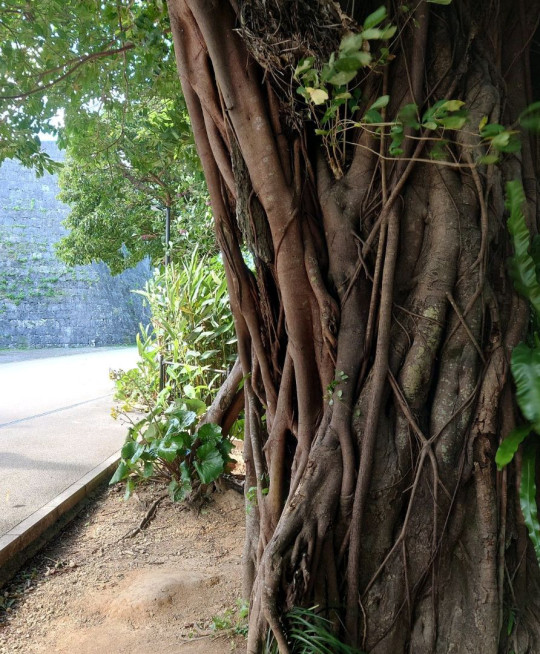
[Photo above: Banyan tree in Shuri Castle Park]
Legends and myths about trees
Forest spirits and natives (5)
Kijimuna – Mischievous red-haired spectres
Kijimuna are legendary small tree spirits from the Okinawa Islands in Japan, who live in trees (generally old banyan trees). They are said to look about 3 or 4 years old and have red hair.
Another name for the kijimuna is bungaya, which means roughly large-headed. The Kijimuna are known to be very mischievous, playing pranks and tricking humans. One of their best-known tricks is to lie upon a person's chest, making them unable to move or breathe such as sleep paralysis. Even though the Kijimuna are tricksters, they have been known to make friends with humans.
They are skilled fish catchers and only eat the left or both eyes of the fish they catch. Therefore, if you become friends with a Kijimuna, you can always get a fish and become rich. They are good at diving and fishing and catch a lot of fish in seconds. But all the fish they catch have no eyes. They can also run around on the water surface and can stand on the water while carrying people.
They are extremely hatred of hot pot lids, octopus, chickens and human farts, and it is forbidden to let them near the Kijimuna. They also die (or are forced to move to another tree), if a nail is driven into the tree in which they live. They will take terrible retribution, including murder, against anyone who breaks these prohibitions.
Nevertheless, as long as one do not break these prohibitions, they are basically harmless to humans, and many lores say that they are "good neighbours" with humans.
[History of Ryukyu Islands (collective name for Amami Islands, Okinawa Islands, Miyako Archipelago and Yaeyama Archipelago)]
The Ryukyu Islands are known to have been inhabited by humans for about 32,000 years.
The Ryukyu Kingdom was a monarchy, existed in the southwestern islands of Japan for about 450 years, from 15th century to 19th century. It developed through diplomacy and trade with China, Japan, Korea and Southeast Asian countries, and the castle of the Ryukyu dynasty, Shuri Castle, was the political, economic and cultural centre of its maritime kingdom. In the late 19th century, the Japanese Government, dispatched troops to oust King Shoutai from Shuri Castle and proclaimed the establishment of Okinawa Prefecture (Ryukyu Disposition). Here, the Ryukyu Kingdom was destroyed.
Genetic studies have shown that populations in the Ryukyu Islands (Okinawa Islands, Miyako Archipelago and Yaeyama Archipelago) have no direct genetic link to mainland China or Taiwanese populations and have identical paternal lines to mainland Japan, and nuclear DNA analysis in 2018 showed that genetically, Ryukyuans are the most closely related, followed by mainland Japanese, from the Ainu (Ref) perspective.
Furthermore, in 2021, a paper on archaeogenetics published in the journal Nature stated that DNA analysis of prehistoric human bones excavated from the Nagabaka (lit. Long graveyard) site in Miyakojima City showed that they were "100% pure Jomon", a research finding that indicates that prehistoric archipelago people came from the Okinawa Islands.

木にまつわる伝説・神話
森の精霊たちと原住民 (5)
キジムナー 〜 いたずら好きな赤毛の妖怪たち
キジムナーは、日本の沖縄諸島に伝わる伝説の小さな木の精霊で、樹木 (一般的にはガジュマルの老木) の中に住んでいる。見た目は3、4歳くらいで、赤い髪をしていると言われている。
キジムナーの別名は「ブンガヤ」であり、「頭の大きい」という意味である。キジムナーは非常にいたずら好きで、いたずらをして人間をだますことで知られている。最もよく知られているのは、人の胸の上に横たわり、身動きや呼吸をできなくさせる「金縛り」だ。そんなキジムナーだが、人間と仲良くなることもある。
魚捕りが巧みであり、しかも捕った魚の左目または両目だけしか食べない。その為、キジムナーと仲良くなれば魚をいつでも貰え、漁運に恵まれる。海に潜って漁をするのが得意であっという間に多くの魚を獲る。でも、彼らが獲った魚は全部目が無い。また、水面を駆け回ることができ、人を連れながらでも水上に立てる。
熱い鍋蓋、タコ、ニワトリ、人間のおならを極端に嫌い、それらのものをキジムナーに近付けるのは禁忌である。また住んでいる木に釘を打たれると死ぬ (或いは別の木への転居を余儀なくされるとも)。これらの禁忌を破った人間に対しては、殺害を含む恐ろしい報復を為す事も辞さない。
然し、禁忌さえ破らなければ基本的に人間には無害な存在であり、人間とは「良き隣人」であると言う伝承が多い。
[琉球諸島 (奄美群島、沖縄諸島、宮古列島、八重山列島の総称) の歴史]
琉球諸島には、約3万2千年前から人類が住んでいたことがわかっている。
15世紀から19世紀までの約450年間、日本の南西諸島に存在した君主制国家、琉球王国は、中国をはじめ日本、朝鮮、東南アジア諸国との外交・貿易を通して発展し、琉球王朝の王城、首里城はその海洋王国の政治・経済・文化の中心にあった。しかし、19世紀後半、日本政府が軍隊を派遣し首里城から国王尚泰 (しょうたい) を追放し沖縄県の設置を宣言した(琉球処分)。これによって、琉球王国は滅亡した。
遺伝子研究では、琉球列島 (沖縄諸島、宮古列島、八重山列島) の集団は、遺伝的に中国本土や台湾の集団との直接的なつながりはなく、日本本土と同一の父系を持つという研究結果や、2018年の核DNA分析から遺伝的に、アイヌ(参照)から見て琉球人が最も近縁であり、次いで日本本土人が近縁であるという研究結果が発表されている。
さらに、2021年には、宮古島市の長墓遺跡から出土した先史時代の人骨をDNA分析した結果、「100%純粋な縄文人」であったとする考古遺伝学の論文が雑誌「ネイチャー」に掲載され、先史時代の列島人が沖縄諸島から来たことを示す研究結果が発表されている。
#trees#tree legend#tree myth#kijimuna#banyan tree#tree spirit#okinawa#ryukyu islands#ryukyu kingdom#syuri castle#legend#mythology#folklore#nature#art#history
156 notes
·
View notes
Text
Review: The Essence of Shinto

I have written before of Yamakage's authorship of multiple antisemitic conspiracy theory books. That said, given that there are not a lot of English language books about Shintō, I find this book is often recommended. It should not be recommended to anyone, not just because of the authorship, but for its misinformation. There is very little actual information that can be salvaged from this trainwreck of a book.
Koshintō is not an ancient practice - it's a new religious movement; an attempt to imagine an ancient Shintō, which is, in my opinion, inherently paradoxical, as the concept of Shintō as the name of a religion (and indeed the concept of a religion itself) were consciously constructed as recently as the Meiji Era, which is the 19th century. The archaeological and historical truth is that we do not know what Yayoi or Jomon period peoples believed, and Shintō is likely very distinct from that, and that is okay. While I understand the impulse to try to reconstruct Yayoi or Jomon era religions, I find the impulse to remove foreign elements like Buddhism to contain elements of xenophobia, and have found the idea of Shintō as truly ancient to be misleading at best. We do not actually have an ancient practice handed down to us. Japanese religious practice, first, is diverse -- regions do things differently. Kyushu area graves, for example, bear continental Chinese influence and have 土神 enshrined at their sides. Secondly, while I do think there is a necessity to undo the damage that State Shintō has done, it is not helpful to do so in a way that, at best, ignores and at worst, contradicts history.
Secondly, Yamakage Shintō is barely attested outside of Motohisa's writings. Many of the practices allegedly specific to Yamakage Shintō are common Japanese New Age theories, along with some condescension of traditional practices. One way to recognize this is his repeated use of the word "spiritual" (which presumably was either written スピリチュアル in the original text). It's ironic, then, that he puts down "bizarre cults and sects" (p.13). The aforementioned paragraph should explain why I am so skeptical of the Yamakage school when there is no such thing as ancient Shintō by definition.
Crucially, there is some dangerous and typical New Age medical misinformation here. He claims that certain chants or practices can heal different physical and mental health symptoms, which is not something anyone should say, much less someone who claims to be a religious teacher. This is a sidenote, but I am hoping that Paul de Leeuw did not absorb any of this, but am concerned as he trained under Yamakage.
Yamakage states "...Shinto leaders have been at the forefront of campaigns to restore the forests..." As much as Westerners want Shintō to be the Green Religion that saves the world, I've had very little luck actually encountering any shrine websites or articles that back this up, outside of the traditional practices of keeping very small sacred forests known as chinju no mori. If anything, the opposite has been documented. See Sacred Forests, Sacred Nation for more on this subject. I would be open to correction on this, but Yamakage provides no sources whatsoever; in fact, he provides no sources throughout his book for any of his factual or historical claims. Presenting the Showa Emperor as a source does nothing but reinforce fascist rhetoric about the emperor being the religious head, as he was at the time of State Shinto, and likely says more about his personal convictions than his religious ones. There is something eerily dystopian and fascistic in Yamakage's description of the people cheerily following the Showa Emperor's example.
I have noticed a tendency in some Japanese people to do what I think of as self-orientalism; an exoticization of your own body and culture to appeal to whites. It seems to me that Yamakage is doing such a thing, while simultaneously appealing to Japanese nationalistic sympathies, by saying it is an ancient, mysterious religion untainted by materialism. Demonizing materialism, in fact, goes against the actual practice of most Japanese -- many, many businesses regularly pray for prosperity and dedicate lamps to shrines, or will get ritual decorations for prosperity known as kumade during the November Tori-no-Ichi festival.
"Ajimarikan" is a chant that is, at best, shoddily derived from Buddhism, as is his use of mudra hand gestures. At worst, he completely fabricated this chant and doesn't even attempt to provide a meaning for this phrase. The Five Great Vowels Chant and the Heavenly Counting Chant are both chants that do not exist outside of this book.
Yamakage Motohisa also repeatedly uses Okinawan/Ryūkyūan religion as examples as if it is a part of Shintō, which it most decidedly is not. There was forced assimilation because of colonization, to my understanding, but the practice is entirely different from Shintō.
This is kind of a briefer overview than I originally intended, but I hope this provides some information on why I dislike Yamakage and this book so much. My hope is that he stops being recommended as any sort of resource and a better one is translated soon.
37 notes
·
View notes
Text
Me, reading a paper on the reverse-flayed piebald horse of Amaterasu: "Why is this author discussing Middle Eastern cosmological imagery? And Mayan ritual practices? Did... did they just dismiss modern Japanese scholarship by quoting a German author from the 1950s? Oh good, now they're talking about Jomon Pottery. At least that's from the right landmass, even if it's a different culture separated by five hundred years. NO WAIT THIS WHOLE SECTION IS ENTIRELY WRONG AMATERASU'S WEAVING MAIDEN ISN'T A DISTINCT FIGURE SHE'S AN ATTEMPT BY EARLY WA WRITERS TO SEPARATE THEIR STATE GODDESS FROM AN OLDER VERSION WHERE SHE INJURED HERSELF IN THE [REDACTED] Oh wait, we're back to the Mayans again... What the Hell is going on here?!"
Academic Author: *approvingly quotes John W Campbell*
Me: "Ah, I see. You're an idiot."
#BRING ME THE REVERSE-FLAYED FLESH OF JOHN W CAMPBELL#god the brainrot he inflicted on people#yes johnny all stories do sound alike if you strip them of context and character and identifying details
69 notes
·
View notes
Note
Just dropping in a quick ask because ironically google is bollocks for trying to find an answer for this.
I saw on your feed a while back about how when it comes to kimonos that you never fold Right Over Left because that's reserved for the dead. I was wondering if that rule applied to any other articles of clothing, like cheongsams, qipao, ao dai etc, or if that's a kimono specific rule?
I'm asking because my brain decided to ask "What if Vampire/Dhampir D&D character, how to show visually without Dracula dramatic route?" And thus I thought I'd ask someone who's probably got far more wisdom in this area than I do before committing any cultural faux paus. Especially since Google etc won't give any answers on the topic that I can find here in the UK.
Thanks for taking the time to read this, and hope everything's going well for you on your side of the planet. Hope you and your loved ones are all alright.
Yeah, google is getting so bad >_<
This is a tricky answer b/c my knowledge is mostly Japan, but Japan actually used to cross the other way, until China adopted the practice and then Japan did as well. (so if you're drawing Jomon or yayoi period stuff, it was the other way around, up until a certain point)
China also did it in a way that "othered" some groups in the region, like "this is how the CIVILIZED people do it" so it is important to check with folks from those groups specifically. I know that Hmong cross the other way, for example.
When it comes to characters tho, that's where it can get tricky. I'd say that it would be a pretty big giveaway to cross the other way, so unless your character wants to out themselves pretty quickly, dressing the way folks around them do would probably make the most sense.
I know Japan at least is mixed on this sort of thing in media, there was a zombie show where the kimono were crossed the other way, but then there was yet another zombie show where they weren't. In Hoshi no Kuni, the gems wear their PJs crossed the other way, but it's not explicitly said why.
Personally, unless I'm drawing art of a character specifically dressed that way, or like a proper actual yuurei, then I tend to stick to the rule.
But I am by NO means the arbitrator on this at all, it's just the history that I've picked up studying and living here, and I know that it can be a sensitive topic, so I'm just telling you what rules I set for myself to be as respectful as possible. Also, my experience is like 90% Japan, so I'm not as knowledgeable about China and Korea as I am Japan, and only know what I observe from looking at posts from folks from those places when they talk about their traditional clothing.
Sorry if that isn't as cut and dry as you'd have hoped for, but I don't think it's my place to call it one way or the other, only just to say what I personally would do in that situation ^_^
If anyone has more specific knowledge/experience in the areas I didn't cover, feel free to add to the post here or in comments!
20 notes
·
View notes
Text
TMMN Alien Society - Analysis
This is only based on little lore we know and is just my analysis and theory

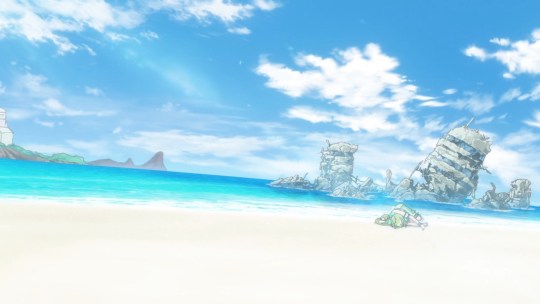
Based on the landscapes, the suken buildings, the vulcano in the background, the tropical plants etc, we can assume this was pre-modern humans Japan, Hunter-gatherers arrived in Japan in Paleolithic times, 30,000 BC but the Japanese archpelago dates back as far as 100,000 years.

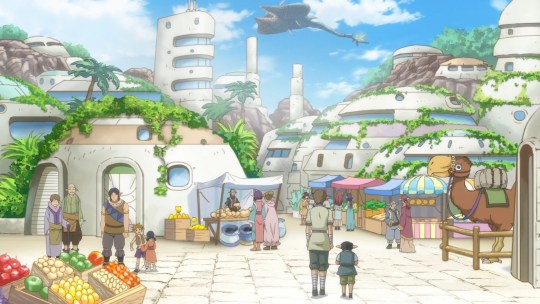
Jōmon Culture ( REAL LIFE / EARTH EVENTS)
Middle Jōmon (ca. 2500–1500 B.C.)
This period marked the high point of the Jomon culture in terms of increased population and production of handicrafts.
Look who has lots of ceramic’s

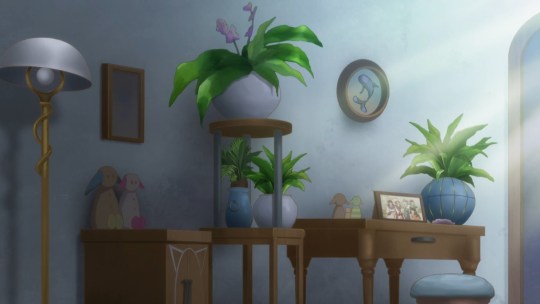
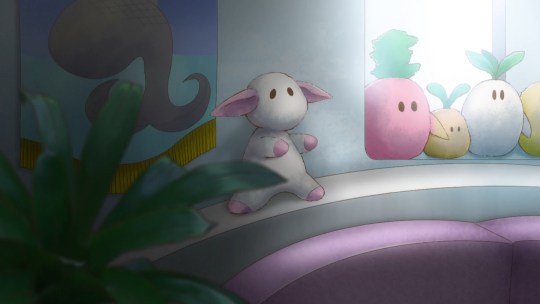
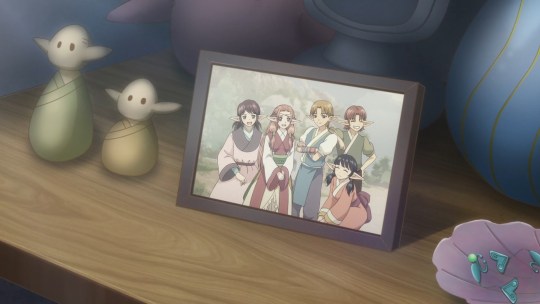
handcrafts

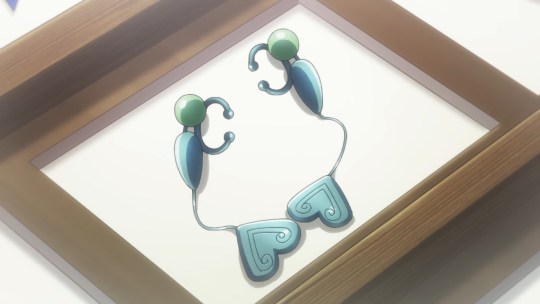
The warming climate peaked in temperature during this era, causing a movement of communities into the mountain regions.

Late Jōmon (ca. 1500–1000 B.C.)
As the climate began to cool, the population migrated out of the mountains and settled closer to the coast, especially along Honshū’s eastern shores. Greater reliance on seafood inspired innovations in fishing technology, such as the development of the toggle harpoon and deep-sea fishing techniques. This process brought communities into closer contact, as indicated by greater similarity among artifacts. Circular ceremonial sites comprised of assembled stones, in some cases numbering in the thousands, and larger numbers of figurines show a continued increase in the importance and enactment of rituals.
Final Jōmon (ca. 1000–300 B.C.)
As the climate cooled and food became less abundant, the population declined dramatically. Because people were assembled in smaller groups, regional differences became more pronounced. As part of the transition to the Yayoi culture, it is believed that domesticated rice, grown in dry beds or swamps, was introduced into Japan at this time.
This all seems to tie perfectly with the alien race in Tokyo Mew Mew New.
Fauna: This goofy bird reminds me of a bird of terror
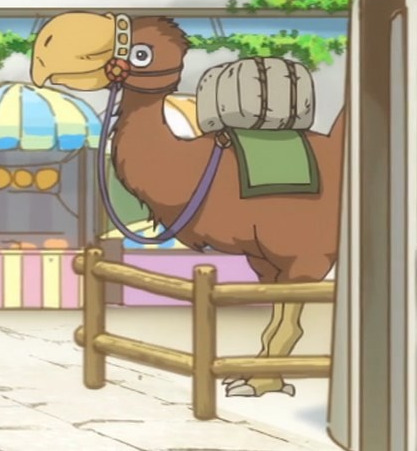
Phorusrhacids, colloquially known as terror birds, are an extinct family of large carnivorous flightless birds that were among the largest apex predators in South America during the Cenozoic era; their conventionally accepted temporal range covers from 53 to 0.1 million years ago. They ranged in height from 1 to 3 m.
Aliens domesticating terror birds? BASED.
But aren’t them specific to America? Yeah but this is an anime with aliens and magical girls and genetic modified humans XD so maybe terror birds could have existed in Japan in this timeline...or some regular herbivore bird simply evolved into a big BIRB.
Well back to the main topic, the enviroment and climate change, like real life records show, this “region” climate began to warm so much it started raising the sea level.


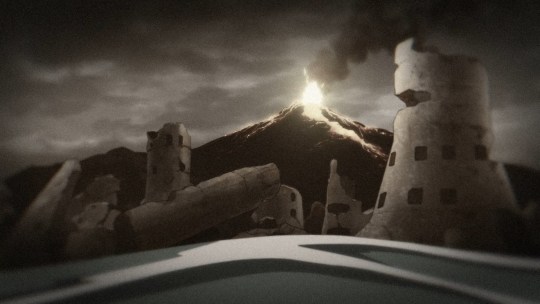
But why some refuse to leave?

if we think of real life experience: wars and dramatic climate changes can lead people to find a new way to survive elsewhere or on the other side to stay and try to overcome the difficulties, ti is always been like that.
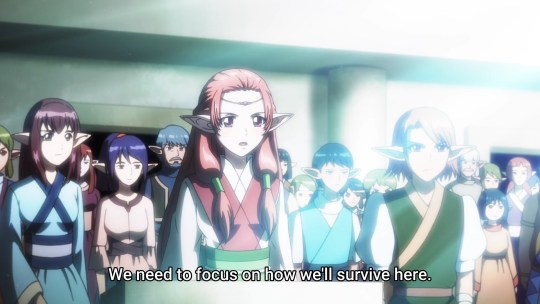
they're afraid of the unknown, what waits them out there may be worst than their fate on earth sentimental behavior,elders etc


My theory is that, they’ve sent a couple of aliens into the new world in order to build a decent new home for everyone, once their new home was established they would come back and take the rest with them.
But sadly the disaster occured too soon, before the previous team could have contact with the “aliens on earth”-
Probably the human species could have develop from the previous “aliens” that survived and lost their “alien” characterisitcs or simply evolved the normal way real humans did
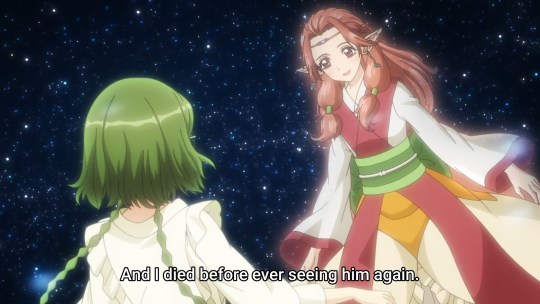
Source for Jomon culture
65 notes
·
View notes
Text
youtube
(video in French only, sorry guys :S)
[À quoi ressemble la Préhistoire au Japon ?], super interesting interview of archeologist Linda Gilaizeau by Nota Bene about Prehistoric and ancient Japan periods.
She first details the actual history of archeology in Japan, then (31:45) surveys keys points of the Jomon, Yayoi and Kofun cultures, before (1:15:34) answering questions from the chat.
Whole talk was immensely useful as, as Linda stresses it herself, studies available mainstrean are sometimes still dated compared to what has been/is actually discovered nowadays! It's so neat to hear her talk about up to date research ^^
Linda Gilaizeau has a popularization channel (her twitter), I'll be sure to check her talks :D
#japan#history#video#archeology#Linda Gilaizeau#Nota Bene#prehistory#jomon period#yayoi period#kofun period#ressources#references#Youtube
33 notes
·
View notes
Text
The Jomon Period is the earliest identifiable period in Japanese history and is broken into several categories—Incipient, Early, Middle, and Late. Comprised of a sedentary culture, the Jomon people are best known for their early pottery skills and are considered to have created the earliest forms of pottery in the world.
46 notes
·
View notes